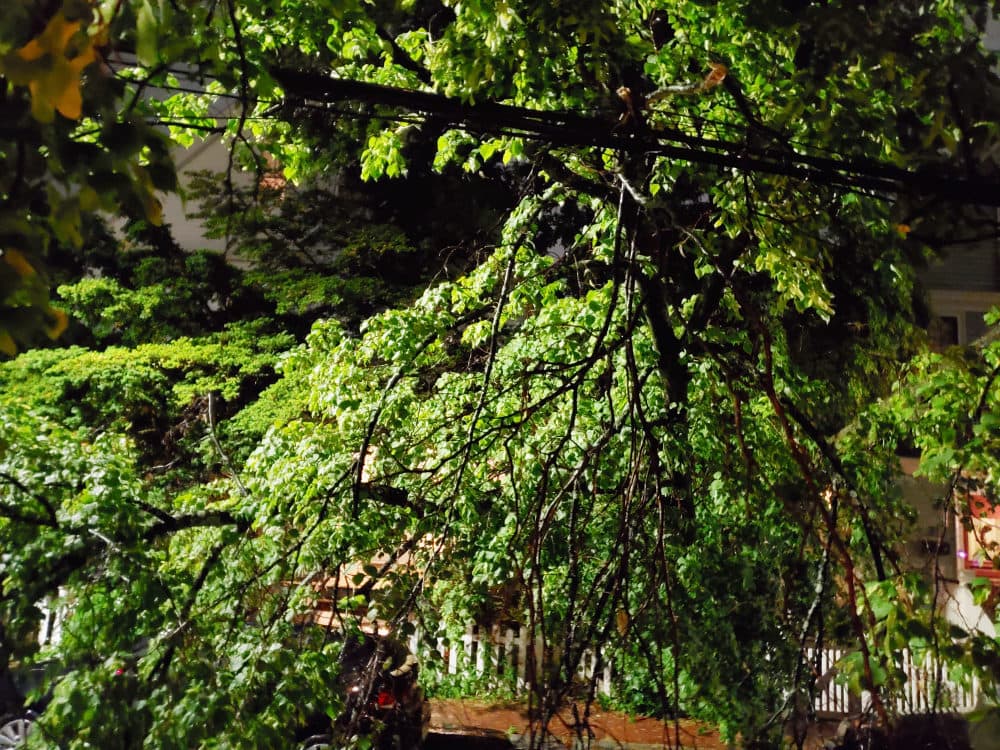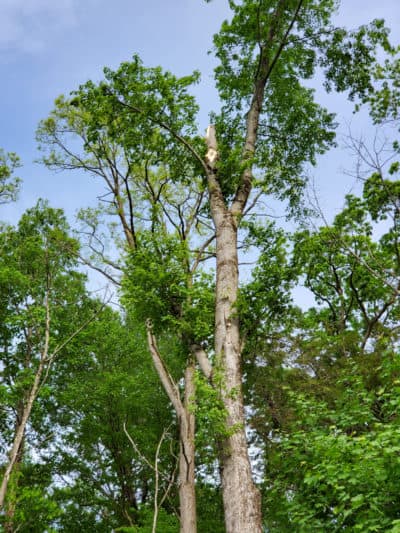Advertisement
Commentary
The trees were here first

One night late in June, in 2021, a couple of weeks before we were set to move away from our home of 38 years, a brief but ferocious thunderstorm passed through our Cambridge neighborhood. Normally I would have pulled up the blinds so that I could thrill to the sight of lightning forking down to the wet pavement. But on this evening we were engrossed in the last episode of one of the dozens of mystery series that filled our pandemic weeks. Rather than watching the storm, we were simply hoping that it wouldn’t knock out the power before the killer was caught.
We didn’t see the lightning cleave the old maple tree across the street from us. But the sound of it falling, the crackle and whoosh of it landing on the second-floor porch outside our living room window — that was enough to overpower the throbbing television score that signaled danger.
We opened the door to see half a tree arced over two cars and our narrow street, with a section of power line delicately looped around its trunk. The two houses facing ours were blacked out, but, miraculously, our outside light went on to reveal a gorgeous, glistening canopy of branches and leaves filling the porch.

Neighbors came out onto the sidewalk and street, warning one another to steer clear of the downed wire and marveling at our narrow escape. Three feet to the right and the tree would have crashed through our window, destroying the television we were so avidly watching and possibly one or both of us along with it.
Someone phoned the fire department, and within minutes fire engines had sealed off the street at either end, moving only when someone from the electric company arrived to shut off the power on our block. Then a city bucket truck arrived, and, illuminated by blinding Klieg lights, the workmen skillfully wrapped the fallen tree trunk in chains, lifted it off the power line, and set its base down on the street. They did the same with the other end of the tree -- the one reclining on our porch.
When the full length of it was laid out on the street parallel to the sidewalk, we could see that from jagged base to top, the tree spanned at least eight car lengths.
But not for long.
The bucket truck left and was replaced by a small tractor-trailer. As two guys with chain saws cut the tree into manageable-sized logs, another two fed them into the roaring chipper on the back of the truck. By 2 a.m. the wooden corpse had vanished, along with the incredibly efficient workers and their vehicles.
“There’s got to be a message in this,” I said to our next-door neighbor. “I just don’t know if the message is Go or Stay.”
As we stood out on the street the next sunny fresh morning, we could see little sign of what had happened beyond a few still sweet-smelling woodchips and piles of sawdust.
“There’s got to be a message in this,” I said to our next-door neighbor. “I just don’t know if the message is Go or Stay.”
We went, following through on our plan to move to a country (or at least countryish) cohousing community.
The home we moved into in Northampton backs onto a trail that leads into a beautiful forest, conservation land marked by a meandering river and stands of impossibly tall, supple trees. For our first several months here, I was alarmed by just how dramatically the oaks and birch and sycamores swayed in the wind that so often seems to coil through the valley we live in. But their flexibility, the ease with which they seemed to bend but not break, reassured me over time. Besides, what were the odds of another tree outside our door being hit by lightning?
Then, almost a year to the day after the Cambridge tree met its untimely demise, we found out. We were eating dinner, the blinds still drawn against the setting sun that had sliced through the windows up until 10 minutes earlier, when a series of violent wind gusts set twigs and branches flying. The room darkened, and bullets of rain started pelting the roof.

Suddenly we heard that unmistakable sound yet again — the startled crack, then the protracted thump of a falling tree. We dashed outside to see a 50-foot length of tree limb spanning the trail, its canopy filling the yard behind our house. One more foot to the left and it would have crashed through the roof of our porch.
This time no city trucks arrived. “It doesn’t matter if the tree was on city-owned conservation land,” explained the guy in the Department of Public Works. “If it lands on your property, it’s up to you to deal with it.”
At first I was annoyed. Surely the city had the responsibility for pruning trees that stood so close to houses. But then I realized the blindingly obvious: The trees were here first. If we chose to buy a house that had been built in their neighborhood, if we demanded the reward of their shade and scent and night music when the breeze rippled around them, then we had to be willing to also assume the risk.
It took about a week to clear out most traces of the broken-off branch. My husband cut it up into manageable lengths with his chain saw, and, unsolicited, our neighbors came by to help us drag the smaller branches and logs into the woods and clear the path once again. Another neighbor has surveyed the trees all around our cohousing community’s periphery, tying bright pink bands around the trunks of dead trees or those most likely to fall onto our houses during the next big storm.
But what we’ll do with this information is still to be decided. Do we fell them before they fell us, making a scarce and much needed natural resource even scarcer to protect our property in the short-term? Or do we pursue our uneasy coexistence, accepting the price we may pay for our short-term pleasure in their greenery and long-term dependence on them to help cool our heating planet?
Meanwhile, no midnight armies of city workers have come to eliminate all traces of what happened. By our choice, some of the debris remains. We’ve kept a few logs, which my husband may turn into table legs or bowls. Twigs and leaves are still scattered in the back yard, souvenirs of our mutual encroachment.
But this time I think I understand the message being conveyed by the tumbling tree branch.
Nature is messy and defiant. It’s self-deceptive to think of it as a destination, as a place we can choose to visit or separate ourselves from. Whether we stay or go, whether we’re on a city street or on the edge of a forest, we are a part of this glorious tangle. Our dominance is as transient as the breeze.
